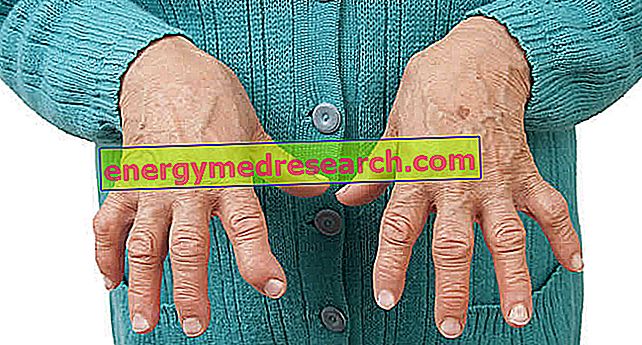Related articles: Liver Cirrhosis
Definition
Liver cirrhosis is a serious liver disease, due to chronic inflammation that over time subverts the structure and functions of the organ.
Cirrhosis is an advanced stage of hepatic fibrosis: repeated damage to the liver produces a progressive destruction of healthy liver tissue, which is replaced by fibrous (scar tissue), dense and non-functioning. Over time, the accumulation of thickening and scarring limits the correct functioning of the organ. If this process is not interrupted, it becomes irreversible and can lead to liver failure and have fatal consequences. Cirrhosis is one of the leading causes of death in the world.
Most cases result from chronic alcohol abuse and chronic viral hepatitis. Among the less frequent causes, we can find metabolic disorders (including: diabetes mellitus, hemochromatosis and Wilson's disease), lesions of the bile ducts (biliary tract obstruction, primary biliary cirrhosis and sclerosing cholangitis), non-alcoholic hepatic steatosis, steatohepatitis, use intense and prolonged of some drugs and exposure to toxic agents.
Most common symptoms and signs *
- anasarca
- Anemia
- Anorexia
- Anuria
- Ascites
- Asthenia
- Muscular atrophy and paralysis
- Muscular atrophy
- Increased transaminases
- Cachexia
- Swollen ankles
- Colaluria
- Coma
- Muscle cramps
- Yellow Diarrhea
- Dyspnoea
- Abdominal distention
- Drumstick fingers
- Pain in a hip
- Spleen pain
- Bruising
- Edema
- Gastrointestinal hemorrhage
- Eosinophilia
- Hepatitis
- Hepatomegaly
- Erythema
- Ease of bleeding and bruising
- I made clear
- Bone fractures
- Swollen legs
- Gynecomastia
- Glycosuria
- Abdominal swelling
- Parotid enlargement
- Increased blood urea
- Hypercholesterolemia
- hyperprolactinaemia
- hypersplenism
- Portal hypertension
- Hyponatremia
- Hypoxia
- Hypotension
- Muscular hypotrophy
- Jaundice
- Lethargy
- leukonychia
- Leukopenia
- Inflated tongue
- Yellow tongue
- macrocytosis
- Functional Meteorism
- Metrorrhagia
- Nausea
- oliguria
- Osteoporosis
- Pallor
- Pancytopenia
- Weight loss
- petechiae
- thrombocytopenia
- itch
- Leg itch
- Itching in the head
- Water retention
- Nosebleeds
- Blood in the ejaculate
- Blood in the stool
- Vaginal bleeding
- Foam in urine
- Drowsiness
- splenomegaly
- Confusional state
- steatorrhea
- Pleural effusion
- xANTHELASMA
Further indications
Cirrhosis is characterized by the presence of regeneration nodules surrounded by fibrous tissue (representing the liver's attempt to repair itself). In the early stages of the disease, the symptoms may be absent or non-specific (eg fatigue, anorexia, malaise and weight loss). Over the years, nausea, abdominal discomfort, itching, swelling of the legs, frequent bleeding and bruising, muscle atrophy, parotid hypertrophy, white nails, drumstick fingers (digital hippocraticism), gynecomastia, testicular atrophy, jaundice (yellowing of the skin and sclera of the eyes) and peripheral neuropathy.
Often, the disorders associated with cirrhosis are evident when damage to the organ is now extensive and the liver no longer works properly. Late manifestations of cirrhosis include portal hypertension, ascites (accumulation of fluid in the abdomen) and liver failure. Portal hypertension can occur with gastro-intestinal hemorrhage from esophageal, gastric, rectal varices or portal hypertensive gastropathy. Cirrhosis can cause splenic congestion with enlargement of the spleen and consequent platelet sequestration and cytopenia. Blood changes are therefore common. Hepatic insufficiency is manifested by coagulopathy, renal failure and hepatic encephalopathy (characterized by mental confusion and an altered level of consciousness, up to the coma). Cirrhosis also contributes to cholestasis with malabsorption of dietary fats and fat-soluble vitamins. Vitamin D malabsorption can contribute to osteoporosis.
Diagnosis often requires tests of liver function and coagulation, blood count, serological tests (for finding a possible viral cause), ultrasound and liver biopsy. The liver is typically palpable and of increased consistency.
Treatment of liver cirrhosis is symptomatic and includes treatment of basic disorders and complications. The goal is to block or slow the progression of the disease, preventing further damage to the liver. The most common therapies include the prescription of diuretics, the integration of vitamins and mineral salts and beta-blocker drugs (to reduce the pressure in the portal vein). In general, alcohol and all hepatotoxic substances should be avoided. In suitable candidates, a liver transplant may be indicated.



